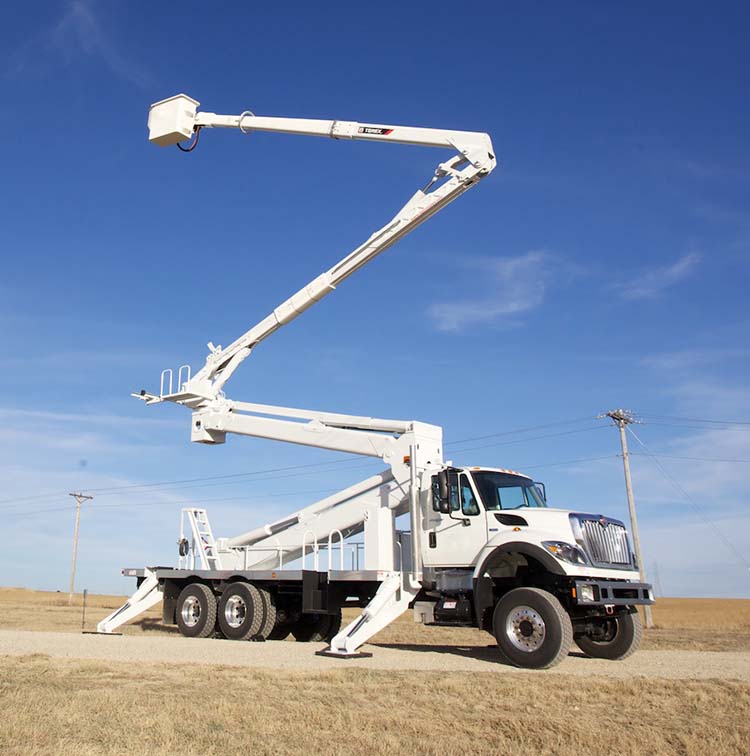
Worker safety is the most important factor for any bucket truck operator. They must always wear body belts and shock-absorbent lanyards that are securely attached to an anchor point on the bucket or boom.
It is also essential that they note the location of any obstructions and do not exceed the manufacturer’s load limits for the bucket or boom. This will reduce the risk of an accident or damage.
Safety First
When the insulated boom & bucket truck, also called a “cherry picker” first appeared in electric utility service work it was a godsend. It made the job of repairing damaged power lines easier, faster, and safer than climbing a telephone pole. Other industries quickly adapted the vehicle to their own needs, including forestry, sign and light, house painting and window washing, and mining.
Bucket truck operators are required to use a full body harness with a shock-absorbing lanyard attached to the bucket and truck anchor points. Hard hats and gloves are essential equipment as well. Falling from an extended bucket could result in severe injury or death.
A daily inspection must be conducted prior to operating the truck. This includes a walk around inspection of the vehicle to ensure all critical lift components are working properly and that it is parked on stable ground and chocked with wheels covered with outrigger pads. Electrical hazards must be de-energized and barricaded before the truck is elevated.
Hydraulic System
The hydraulic system in an excavator allows the equipment to move large, heavy loads over long distances. It’s also used for operating the arm and bucket that work at the end of the boom, and even to tilt the cab. In fact, any earthmoving equipment that has a track uses a hydraulic system to power the tracks and wheeled mechanisms.
With a conventional hydraulically operated bucket truck, if the overriding hydraulic controls on the mast down at the base of the boom become disabled, as by a tree branch falling across them or the like, hazardous movement of the bucket results without the lineman in the aerial bucket being able to control it. To avoid this, the present invention provides a manually operable safety lever to reduce, as by venting, the pneumatic pressure in insulating hoses extending down through the boom and a pneumatic switch mounted on the truck body.
This eliminates the need to keep the engine running while the boom is deployed, saving fuel and money. This is especially true with an articulated over-center boom truck that has multiple positions for the platform or bucket, rather than one fixed position.
Platform Lifter
Workspace capacity and side reach are two important characteristics that should be taken into account when selecting the best bucket truck for a job. Capacity is the amount of weight that can be carried in the bucket with the manufacturer-approved load limit in place, and side reach is how far a boom can extend from the truck body.
If a project is performed near a roadway, for example, it is vital to have adequate side reach to safely position the equipment when working on signs on the shoulder or travel lane of a busy road. The ability to rotate or flash beacon strobe lights to warn motorists is also a must.
Workers in a bucket or work platform must wear a body harness and shock-absorbing lanyard attached to an anchor point provided by the bucket or lift and hard hats for head protection. Having emergency procedures on hand is also critical in case of an accident.
Cab Safety
The cab on a boom or bucket truck provides the operator with an environment that protects them from noise, vibration, weather and hostile work conditions. It also helps keep them safe from musculoskeletal injuries and provides comfort during long working hours.
Ergonomics in excavators goes far beyond comfortable armrests and wrist rests or adding a cup holder for the morning coffee. It means evaluating determining factors, like the level of vibration and how it might affect different body types. Studies suggest that the driving speed of equipment is a major factor in aggravating vibrations. However, the weight and posture of the driver has a less significant effect on the vibrations.
Manufacturers continue to make advances in cab ergonomics. They may conduct focus groups or laboratory experiments to determine if there are more ways to make equipment easier and safer for operators to use. This might mean adding curves to control structures for a better fit of hand and wrist, or redesigning the stroke of joystick controls.




